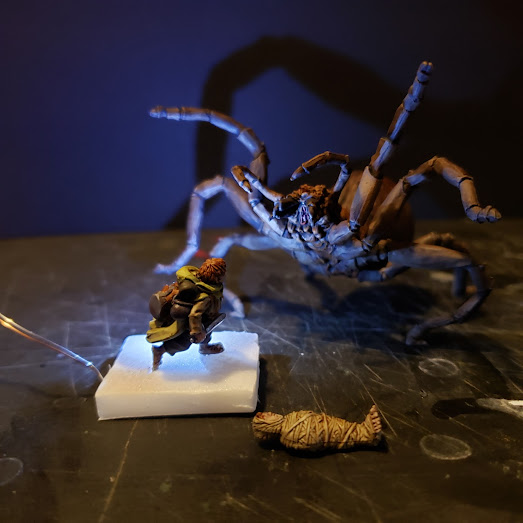In this part of the build, the terrain build was completed and the back-lit shadow of the tower of Cirith Ungol was added.
Molding the Left Wall
The completed part of the scene was covered in plastic wrap so that when dry, the two parts can be separated again for painting, wiring and other setup activities.
The plastic wrap is loose fitting.
Then the left wall was installed with pins and gently clamped to remove any bowing, forcing the walls to look square.
The gap was then filled with Sculpta-mold and set aside for a few days to dry.
The Upper Rock Faces
With left wall dry, the nook can be disassembled and any missing rock feature texture added. For this step latex caulk was used. It is harder to work with than sculpta-mold but has a longer working time and dries much faster (overnight). The texture shown here is achieved directly with the nozzle of the caulk tube.
The left wall with latex caulk texturing.
The right wall with latex caulk texturing.
Getting very close.
Finishing with Sand
I have a small container of sand I use to add fine detail to terrain. The sand is irregular and has small pebbles and various grain sizes.
container of sand
To apply the sand I use PVA glue (Elmer's) and a little water on my brush. Alcohol (rather than water) might work better to seal the sand with glue afterwards but since we will be painting the sand, this is not necessary and the whole piece is sealed in another step.
Glue for the sand
The surfaces where rubble would collect are then painted and sprinkled with sand. Shaking/sifting the sand in the cup causes different sizes of the sand to separate out (larger to the top) and you can select the more fine layer for application to the ground surfaces and the larger pieces to fill in areas at the base of the walls/cliffs.
Left wall has some more texture.
Sealing
To seal the terrain piece, a popular technique of mixing Matte Mod Podge with black paint was used.
Once sealed the contrasting surfaces and textures look very uniform
Painting this will be easy!
The Tower Silhouette
The Tower of Cirith Ungol is supposed to be in background overlooking the path.
A black cloudy skyline was painted on a small piece of photo paper. Photo paper was chosen because it heavy and sealed. It is less likely to be deformed but the wet painting process, and will accept and hold a curve when fit into the back of the book nook box.
A template was created from cardboard in the shape of the tower and painted black.
The Tower and hillside cut from thick cardboard.
The pieces easily slide inside the box and fit without glue. Using a single red LED something approximating the final configuration was possible.
Prototype back lighting.
Next Steps
- Terrain Painting
- Silhouette lighting
- Samwise installation / lighting
- Front scene lighting installation
- Wood Box Shell
- Miniatures and frame installation
- Arduino Nano light programming and finalization







































